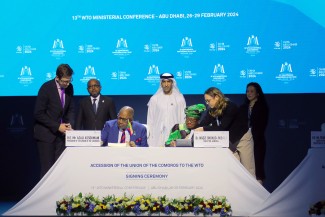Adaptability, accountability and active inclusion are core features for development programs in today's world. Adaptability requires constantly responding to day-to-day situations, or, more fundamentally, to systemic changes in the global environment – and sometimes because of the positive or negative effects of your own interventions! Accountability and transparency require neutral and independent assessments to verify that public investments are appropriately delivered. Active inclusion means that key stakeholders are involved, have ownership, and focus the multiple strengths of many partners into a dedicated initiative.
Evaluations play a key role in ensuring adaptability, accountability and active inclusion. They provide an independent review of the development initiative, explore what has been achieved or not, and whether the theory of change is appropriate. They are also a valuable resource to learn from the intervention's experience to-date, as well as from the external situational context to ensure transparency and accountability, and importantly, to engage and ascertain the views and contributions of partners.
In this context, the partnership of the Enhanced Integrated Framework (EIF) has recently undertaken an evaluation of the initiative, from the birth of the EIF from the original Integrated Framework to late 2021. Although there have been targeted assessments in-between, this was the first comprehensive evaluation of the EIF since 2014. It has been a fascinating process looking at the results and model of the EIF through global analysis, as well as specific analysis of results and operations in a large sample of half of the EIF countries. Over 140 in-country and more than 60 global stakeholder interviews were done, in addition to stakeholder surveys.
Representatives of the EIF partnership led and oversaw the evaluation process from conception to completion through an independent external consultancy firm. In standard practice, the evaluation assessed the EIF results and model through the optics of the OECD DAC principles, examining relevance, effectiveness, impact, coherence, efficiency and sustainability. A hallmark of the evaluation was the highly participatory engagement of stakeholders at key points during the process.
The evaluation was undertaken shortly before the end of the second phase of the EIF. Therefore, the set of seven concluding recommendations are focused on the short and medium term. Three are targeted towards the remaining period of implementation of Phase 2 of the EIF (immediate recommendations) and four aim at a more strategic level. The three immediate recommendations focus particularly on ensuring effective learning and sustainability, as well as oversight, particularly of the closure process of Phase 2. The four strategic recommendations focus on the need for continued support to Least Developed Countries (LDCs) in a COVID-19-affected world, as well as looking towards a rejuvenated partnership, reworked Diagnostic Trade Integration Study (DTIS) process, and stronger linkages to innovative financing solutions.
Informed by the findings and recommendations from the evaluation, the EIF is working to prioritize efficiency, sustainability of results, and harvesting lessons as current projects mature and conclude. To guide this process, a partner-led management response is setting out a series of clear actions to integrate core aspects of the immediate recommendations into EIF operations for the remaining operational period through to the end of 2023.
Likewise, in the spirit of transparency and accountability, an upcoming series of articles on the EIF's Trade for Development News platform aims to share the results and lessons generated from this exercise. With three volumes totaling 382 pages, there is indeed a wealth of information to share. With an extensive and wide-ranging stakeholder group revolving around the EIF's core partnership of 51 countries, 24 donors and eight global agencies, effective engagement with the results of the evaluation will be key. Stay tuned to the series for lessons gained so far on key areas, including strengthening institutions and trade policy, the role of the private sector and civil society, as well as experiences and lessons in catalyzing resources to spur on the role of trade for development in the LDCs.
If you would like to reuse any material published here, please let us know by sending an email to EIF Communications: eifcommunications@wto.org.



